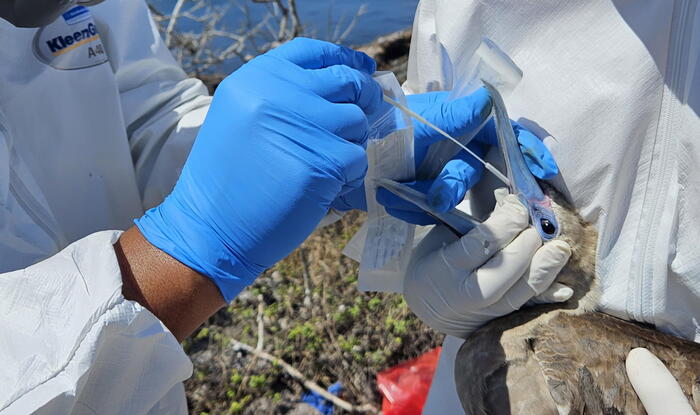Zoonotic infectious diseases that travel between animals and humans
In December 2019, 'Corona 19' first revealed its existence to the world under the name of 'Wuhan Pneumonia', and three months after that, when the World Health Organization (WHO) declared a pandemic, this Interest in the unknown virus has exploded.
From the trivial content that the virus was named 'Corona', which means crown in Latin, because it resembles a crown when viewed under an electron microscope, to the slightly unfamiliar word zoonotic infectious disease.
Zoonotic diseases refer to infectious diseases caused by pathogens, such as viruses or bacteria, that can pass between animals and humans.
Infectious diseases such as malaria, which is commonly transmitted by mosquitoes, and SFTS, which are transmitted by ticks, also fall under zoonosis.
Do you remember the MERS outbreak in 2015?
At the time, the health authorities were beaten for emphasizing 'don't come into close contact with camels', which did not fit our reality, and MERS is also a typical zoonotic disease.
One of the main hosts is the camel.
AIDS, Ebola, and Mpox (monkey smallpox) are all zoonosis.
The most threatening moment of a zoonotic disease is when the pathogen that lived in an animal's body passed over to a person through some chance.
Experts use the expression 'crossed the species barrier', but this is not common.
However, as we have seen with this COVID-19, if the mutation is successful (from the virus's point of view), the risk of rapid spread among people who have no immunity to this new pathogen is very high.
When asked why there are so many viruses that cross the species barrier, scientists have explained this.
We are suffering from low birth rates, but the number of people continues to rise, with the world population surpassing 8 billion last month, and as a result, the territory of wildlife is being invaded and destroyed.
In an environment where contact between humans and animals is bound to increase, a food culture that preys on wild animals is developing in some areas.
The ecosystem is destroyed by human greed, and wild animals are in extreme environments, and in this process, we are exposed to viruses.
How Hendra virus came to humans
Let's take a look at a slightly unfamiliar virus called 'Hendra'.
The virus first appeared in Brisbane, Australia in 1994, and its first victim was a retired racehorse.
Subsequently, other horses were additionally infected, killing 7 horses, and severe flu symptoms also appeared in the trainer.
The trainer was treated at the hospital but later died.
The coachman who helped the trainer got infected but got over it, and the veterinarian was asymptomatic.
Scientists confirmed the existence of the new virus, but it took about two years to identify it and figure out that the 'flying fox' was the host.
It is a virus that is fatal enough that one out of two people who are exposed together and subsequently infected die, but infections caused by Hendra did not occur routinely.
It has been an unresolved question for some time why a virus that existed in the past but was not threatening to humans came to the fore, under what circumstances the virus spreads to horses or humans, and under what conditions it does not spread.
A recent study that answers this question was published last month in Nature Briefing.
To begin with, when bats are placed in extreme environments where they have to worry about food, the risk of spreading a deadly virus to humans increases.
A joint US-Australian research team collected and analyzed data from 1996 to 2020 on the location of flying foxes' nests, food sources, climate and habitat loss.
In the past, flying foxes moved from forest to forest in groups in search of nectar, but gradually they settled in small groups near cities and rural areas, and found increased contact with horses and humans.
For example, in eastern Australia, as the habitats where flying foxes spend the winter are shrinking, bats stressed by the difficulty of finding food move away from their wintering grounds and move closer to cities.
This phenomenon also occurs when food is scarce due to El Niño.
Divided into smaller herds, the number of herds increased, and they came closer to horses and people.
It has tripled since the early 2000s, and by 2020 320 herds were identified.
- X axis: Week
- Y axis: Percentage of bat excrement puddles positive for Hendra virus
- Beige: Existing habitat
- Gray: New wintering site
- (a): No food shortage in the previous year
- (b): Food shortage in the previous year
The joint research team narrowed the period and conducted additional research.
From July 2011 to July 2014, we analyzed Hendra virus data detected in bat feces collected from nine flying fox bat habitats.
Flying foxes shed the virus during the winter in their new habitat.
And it was confirmed that relatively more viruses were released when food was scarce in the previous year.
(Refer to the graph)
So, if an El Niño event occurs, how many years later will Hendra virus exposure increase?
Not necessarily either.
The research team noted that there was only one Hendra virus infection in 2020, even though El Niño occurred in 2018 and the drought in 2019, the following year, was severe.
**If the 'Go to View' button is not pressed, try moving the address to the address bar and pasting it.















